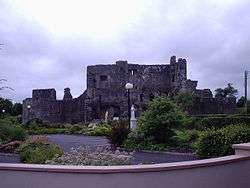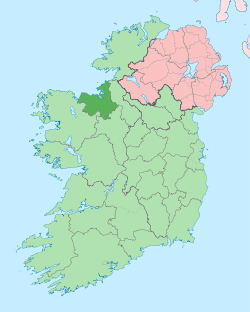Ballymote
| Ballymote Baile an Mhóta | |
|---|---|
| Town | |
|
Ballymote Castle | |
 Ballymote Location in Ireland | |
| Coordinates: 54°05′23″N 8°31′00″W / 54.0896°N 8.5167°WCoordinates: 54°05′23″N 8°31′00″W / 54.0896°N 8.5167°W | |
| Country | Ireland |
| Province | Connacht |
| County | County Sligo |
| Elevation | 76 m (249 ft) |
| Population (2011) | |
| • Urban | 1,539 |
| Time zone | WET (UTC+0) |
| • Summer (DST) | IST (WEST) (UTC-1) |
| Irish Grid Reference | G662150 |
Ballymote (Irish: Baile an Mhóta, meaning "town of the motte/mound") is a market town in southern County Sligo in the province of Connacht, in the north-west of Ireland.
It is a historic town, with Ballymote Castle, the last and the mightiest of the Norman castles in Connacht.[1] This castle, dating from 1300, was built by Richard de Burgh. It also has a Market House, a three-bay, two-story building currently used by the South County Sligo Community Mental health service of the Health Service Executive.
Transport
Ballymote lies on regional roads R293, R295 and R296, and on the main Dublin to Sligo railway line. Ballymote railway station opened on 3 December 1862.[2]
Demography
In 1900 Ballymote had a population of 1145,[3] compared to 1539 in 2011.
Sport
A number of sports are played in the town, including Gaelic football at Corran park, soccer at Brother Walfrid Memorial park and athletics at the track around Corran Park. Numerous other sports are played, particularly at under-age level. Golf is played at a nine-hole course on the outskirts of the town.
September 11 memorial
The Mayor of New York City, Michael Bloomberg unveiled Ireland's national monument to the 69th Infantry Regiment (aka The Fighting 69th) and Michael Corcoran in Ballymote on 22 August 2006. At the foot of the monument is a piece of steel from the World Trade Center in New York, which was attacked on September 11, 2001. The steel was donated by the family of a local man who died in the attack.
People

Some well-known people from Ballymote and the surrounding areas include:
- Brother Walfrid, the founder of Glasgow Celtic Football Club
- Francis Taaffe, 3rd Earl of Carlingford, who rose to the rank of field marshal in the Austrian Army, was born here in 1639
- Michael Corcoran, brigadier general of the 69th Infantry Regiment during the American Civil War
- John Perry, a Teachta Dála and Minister of State for Small Business in the 31st Dáil
- Eamon Scanlon, a Teachta Dála in the 32nd Dáil, previously a Senator in the 22nd Seanad
Annalistic references
From the Annals of the Four Masters:
- M1300.3.The castle of Ath-Cliath-an-Chorainn (i.e.of Ballymote) was commenced by the Earl.
- M1317.5.The castle of Ath-cliath an Chorainn (i.e. of Ballymote) was demolished.
See also
- List of towns and villages in the Republic of Ireland
- Market Houses in the Republic of Ireland
- Book of Ballymote
- Henry Taaffe, 12th Viscount Taaffe
- Ballymote Castle
References
- ↑ "Ballymote Castle". Irelandseye.com. Retrieved 28 May 2007.
- ↑ "Ballymote station" (PDF). Railscot - Irish Railways. Archived (PDF) from the original on 26 September 2007. Retrieved 2007-09-07.
- ↑ "Description of County Sligo from Atlas and Cyclopedia of Ireland (1900)". Library Ireland. Retrieved 24 February 2009.
External links
| Wikimedia Commons has media related to Ballymote. |
-
 Ballymote travel guide from Wikivoyage
Ballymote travel guide from Wikivoyage  "Ballymote". Encyclopædia Britannica. 3 (11th ed.). 1911.
"Ballymote". Encyclopædia Britannica. 3 (11th ed.). 1911.- Ballymote Pictures and Travel Review
- Ballymote Town Website
- Ballymote Parish

